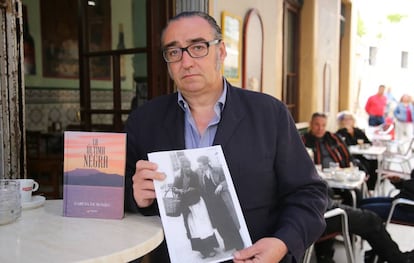From slavery to freedom: the extraordinary story of Cándida Huelva
Born in 1845 in a Portuguese colony, she made it to Spain and became a local celebrity until her death at 110


The line between fact and fiction concerning Cádiz’s last female victim of the slave trade is blurred, but what is known is that Cándida ‘La Negra’ was born into slavery in 1845 in the Portuguese colonial city of Luanda – now Angola’s capital – and died a free woman 110 years later in Puerto de Santa María, in Cádiz.
By then she had become a local legend in a city where nobody had seen a black person before, and it became common for children growing up between the 1920s and 1950s to be kissed goodnight with the cautionary words, “Go to sleep now, or Cándida la Negra will get you.”
Cándida died in terrible poverty in 1951 with little known about her life
This tall woman who dressed in black and carried a basket filled with coal, knew what it was like to live both as a slave and as a free woman. She experienced two continents and two centuries, dying in terrible poverty in 1951 with little known about her life despite being a familiar figure in the community.
Still remembered as humble and friendly by Cádiz’s oldest residents, Cándida Huelva is now the subject of a semi-fictional work by lawyer Joaquín G. Romeu. Titled La Última Negra (The Last Black Woman), it follows the course of her life, first as a slave in Luanda, and then as a free woman living on the fringes of a Spanish society dominated by bourgeois industrialists and hypocrisy.
The first person to try to unravel the mystery surrounding Cándida was the local historian Manuel Pacheco, who met her at the end of the 1940s when he was just a child. His curiosity had been stirred by the fact that the woman his mother had so often warned him about actually lived in the city. Many years later, in 2006, Pacheco’s investigations into her life would result in an article called “The Face of Slavery: the enthralling story of Cándida la Negra.”
The article explains how Cándida was washed up on the beaches of Puerto de Santa María as a teenager in the mid 19th century, following a storm that wrecked the boat she was traveling on with her master. Pacheco claims an old peasant found her and took her home to his house on Lechería Street 5 (now Cervantes Street), where she lived until the peasant’s death.
A unique figure
Pacheco’s reconstruction of these events was based on oral accounts from people who had spoken to Cándida many years earlier, before she decided to stop sharing her personal history with strangers. What can be taken as fact, however, is her date of birth, which municipal records show as May 2, 1845. These records also say that she was born in Luanda where a surname would indicate ethnic origin, master or place of origin. In Cándida’s case, Pacheco traced her surname ‘Huelva’ to slave-owning families from Huelva.
The historian suggests she may have been in the process of being sold, as child-bearing women were highly valued in the slave trade. But Joaquín G. Romeu points out that slavery on mainland Spain had been abolished in 1837, after which it was only tolerated in Spanish colonies such as Cuba and Puerto Rico as well as in Portuguese colonies. Hence, the novel depicts Cándida as a victim of the illegal slave trade that thrived between Cádiz and La Havana.
It’s a story that could now almost make her seem like an activist Author Joaquín G. Romeu
Not convinced by Pacheco’s version of events, Romeu believes it was more likely that when the ship was offloading its merchandise in the port, Cándida managed to escape and was henceforth a free woman. Not that her freedom would have brought her much joy. After the Cadiz Slave Company stopped trading in the 18th century, it was hard to come across anyone like Cándida in the area and, as her legendary bogie woman status suggests, she would not have been easily accepted by the community.
After living with the old peasant, it would seem that Cándida got together with a Romani man who sold coal for a living. The couple, who had no children, would not make their match official until the 1940s when the Jesuits forced Cándida to be christened as Cándida Huelva Jiménez and to tie the knot. By that time, the locals had grown used to seeing her at the market with her coal basket, as she appears in the only photograph known to remain of her.
Cándida also did odd jobs for families in the city, and lived until the age of 110. It was then that she had an accident involving a coal heater and was rushed to San Juan de Dios Hospital, where she writhed in agony from burns for 20 days before finally breathing her last.
“It’s a story that could now almost make her seem like an activist, though I doubt that she would have been aware of that,” says the author. “She just wanted to survive and be able to eat every day, which, at that time, was quite an achievement in itself.”
English version by Heather Galloway.
Tu suscripción se está usando en otro dispositivo
¿Quieres añadir otro usuario a tu suscripción?
Si continúas leyendo en este dispositivo, no se podrá leer en el otro.
FlechaTu suscripción se está usando en otro dispositivo y solo puedes acceder a EL PAÍS desde un dispositivo a la vez.
Si quieres compartir tu cuenta, cambia tu suscripción a la modalidad Premium, así podrás añadir otro usuario. Cada uno accederá con su propia cuenta de email, lo que os permitirá personalizar vuestra experiencia en EL PAÍS.
¿Tienes una suscripción de empresa? Accede aquí para contratar más cuentas.
En el caso de no saber quién está usando tu cuenta, te recomendamos cambiar tu contraseña aquí.
Si decides continuar compartiendo tu cuenta, este mensaje se mostrará en tu dispositivo y en el de la otra persona que está usando tu cuenta de forma indefinida, afectando a tu experiencia de lectura. Puedes consultar aquí los términos y condiciones de la suscripción digital.










































